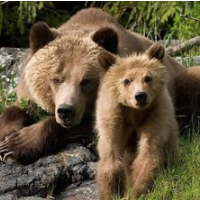Government May Take Grizzlies Off Threatened-Species List
 (photo: National Park Service)
(photo: National Park Service)
By Matthew Brown, Associated Press
BILLINGS, Mont. — The federal government is proposing to lift threatened-species protections for hundreds of Yellowstone-area grizzlies, opening the door to future hunts for the fearsome bears across parts of three states for the first time since the 1970s.
The proposal caps a four-decade, government-sponsored effort to rebuild the grizzly population and follows the lifting of protections in recent years for more than a dozen other species, including the gray wolf, brown pelican and flying squirrel.
Hunting within Yellowstone National Park would still be prohibited. But the proposal could allow animals to be taken in surrounding parts of Montana, Idaho and Wyoming.
“By the time the curtain closes on the Obama administration, we are on track to have delisted more species due to recovery than all previous administrations combined,” U.S. Fish and Wildlife Service Director Dan Ashe told The Associated Press. “We’ve done that because of several decades of hard work, like with the grizzly bear.”
Grizzlies once roamed much of North America and came to symbolize the continent’s untamed wilderness. Hunters and trappers had nearly wiped them out across most of the Lower 48 states by the late 1800s.
Thursday’s announcement came as conflicts between humans and grizzly bears have been on the rise, including six people fatally mauled since 2010. A record 59 bears were killed by humans last year, often by wildlife managers following attacks on livestock.
That has resulted in pressure to turn over management of the animals to states, in part so hunting can be used to control the population. But wildlife advocates declared the government’s announcement premature and warned that it could reverse the species’ gains.
“There’s still a lot of uncertainty facing this population,” said Sylvia Fallon, senior scientist for the Natural Resources Defense Council.
A final decision on the proposal is due within a year. It could come sooner if state wildlife commissioners act quickly to adopt rules on how much hunting is allowed. Those rules are not mandatory under the federal proposal, federal officials said.
Montana Gov. Steve Bullock said the bear population would be responsibly managed by state wildlife officials. If a public hunt for the animals is pursued, the Democrat said, it could be done in a way that avoids killing bears that live on the periphery of Yellowstone.
“Yellowstone wildlife is treasured. We understand that. We’ll manage them in a way that addresses that sensitivity,” Bullock said.
Republican Wyoming Gov. Matt Mead said ending federal control over grizzlies would be “good for the species, for Wyoming and for the West.” In Idaho, Republican U.S. Sen. James Risch said the state’s track record on other predators, including gray wolves, shows it can manage bears at a sustainable level.
The federal government has spent roughly $20 million to $30 million to date on grizzly recovery efforts in the Yellowstone area, according to Fish and Wildlife Service spokeswoman Serena Baker.
Protections would remain in place for about 1,000 bears in and around Glacier National Park and smaller populations elsewhere in Montana, Idaho and Washington state. Grizzlies are not protected in Alaska, where hunting has long been allowed.
Grizzlies in the Lower 48 were added to the endangered and threatened species list in 1975. In the intervening years, the Yellowstone population has increased from 136 animals to an estimated 700 to 1,000 today, according to government researchers.
Yet after years of growth, the grizzly population plateaued in recent years, and some of the wildlife advocates say it’s too soon to allow hunting. Also opposed are dozens of American Indian tribes that view the grizzly as sacred.
Formal consultations between the tribes and the Interior Department are ongoing, although Ashe said the issue is unlikely to be resolved.
Federal and state officials said limits on how many bears can be killed will safeguard against a collapse in the bear population.
If bear numbers drop below 600, intentional killings through hunting and the removal of bears that attack livestock would be prohibited. Exceptions would be made for bears that threaten public safety. More hunting would be allowed when bear numbers increase.
Grizzly numbers rebounded despite declines in some of their key food sources, including cutthroat trout and the nuts of whitebark pine, a high-elevation tree devastated by bark beetles and an invasive fungus.
Environmentalists argue that those declines are good reasons to keep protecting the region’s grizzlies.
The last legal hunts for Yellowstone-area bears happened in the 1970s. The animals were taken off the threatened species list in 2007, but that move was struck down and protections were restored two years later after environmental groups challenged the government in court.
Subsequent government-sponsored studies have shown grizzlies are able to adapt easily to different types of food.
State officials and members of Congress have pointed to the case of the grizzly bear as an example of how the Endangered Species Act needs changes so animals do not linger under federal protections once they are recovered.
Ashe said reforms are not needed as much as money to help species recover.
Associated Press Writer Mead Gruver in Cheyenne, Wyoming, contributed to this report.
To Learn More:
Federal Panel Says Yellowstone Grizzly Bears No Longer Need Protection (by Noel Brinkerhoff and Danny Biederman, AllGov)
First Case of Fish Removed from Endangered Species List Thanks to Habitat Restoration (by Noel Brinkerhoff, AllGov)
Wyoming Ranchers Knock Gray Wolf Off Endangered Species List (by Matt Bewig, AllGov)
- Top Stories
- Unusual News
- Where is the Money Going?
- Controversies
- U.S. and the World
- Appointments and Resignations
- Latest News
- Musk and Trump Fire Members of Congress
- Trump Calls for Violent Street Demonstrations Against Himself
- Trump Changes Name of Republican Party
- The 2024 Election By the Numbers
- Bashar al-Assad—The Fall of a Rabid AntiSemite






Comments